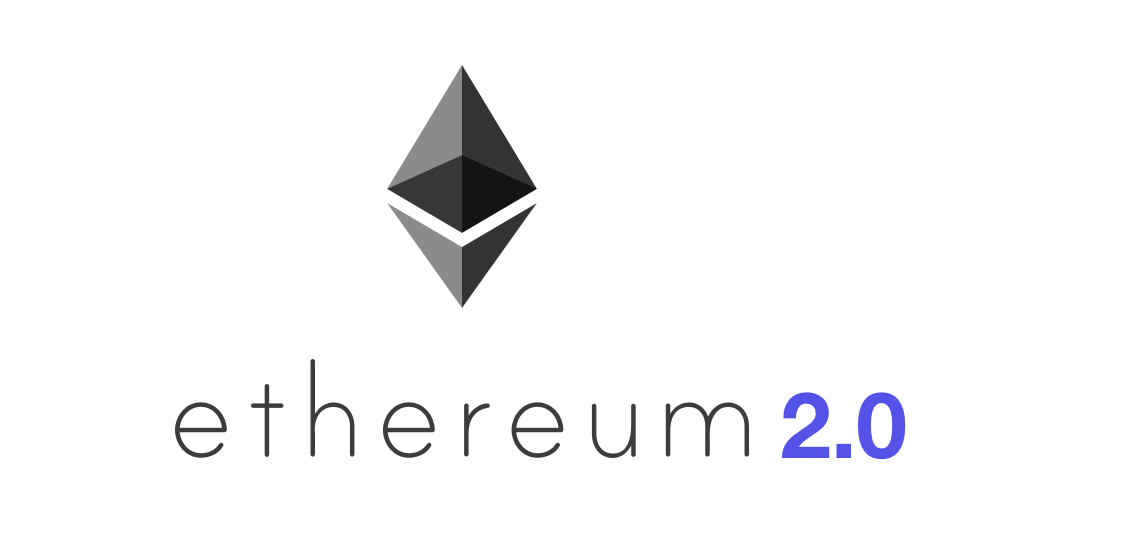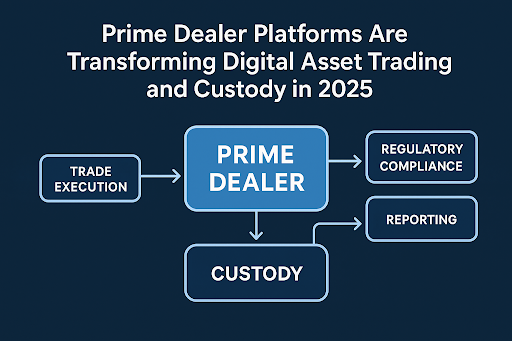In November 2013, a young Russian-Canadian college student at the University of Waterloo and co-founder writer for Bitcoin Magazine published a whitepaper that proposed the development of a blockchain platform supporting a generalized scripting language and application development.
His name was Vitalik Buterin, and his idea quickly caught fire. Buterin was joined by seven other founders to create Ethereum, a smart contract platform for building decentralized applications. They launched a crowdsale to fund development, raising 3,700 BTC in twelve hours, worth around $2.3 million at the time. The project went live a year later in 2015.
The early promise of Ethereum was to create a world computer — a decentralized world computer — that would execute anyone’s code in exchange for a fee, from running a token sale to distributing loans. In an early talk, Buterin likened Ethereum to something like Google Play: Ethereum would allow developers to upload applications to the blockchain for use anywhere in the world.
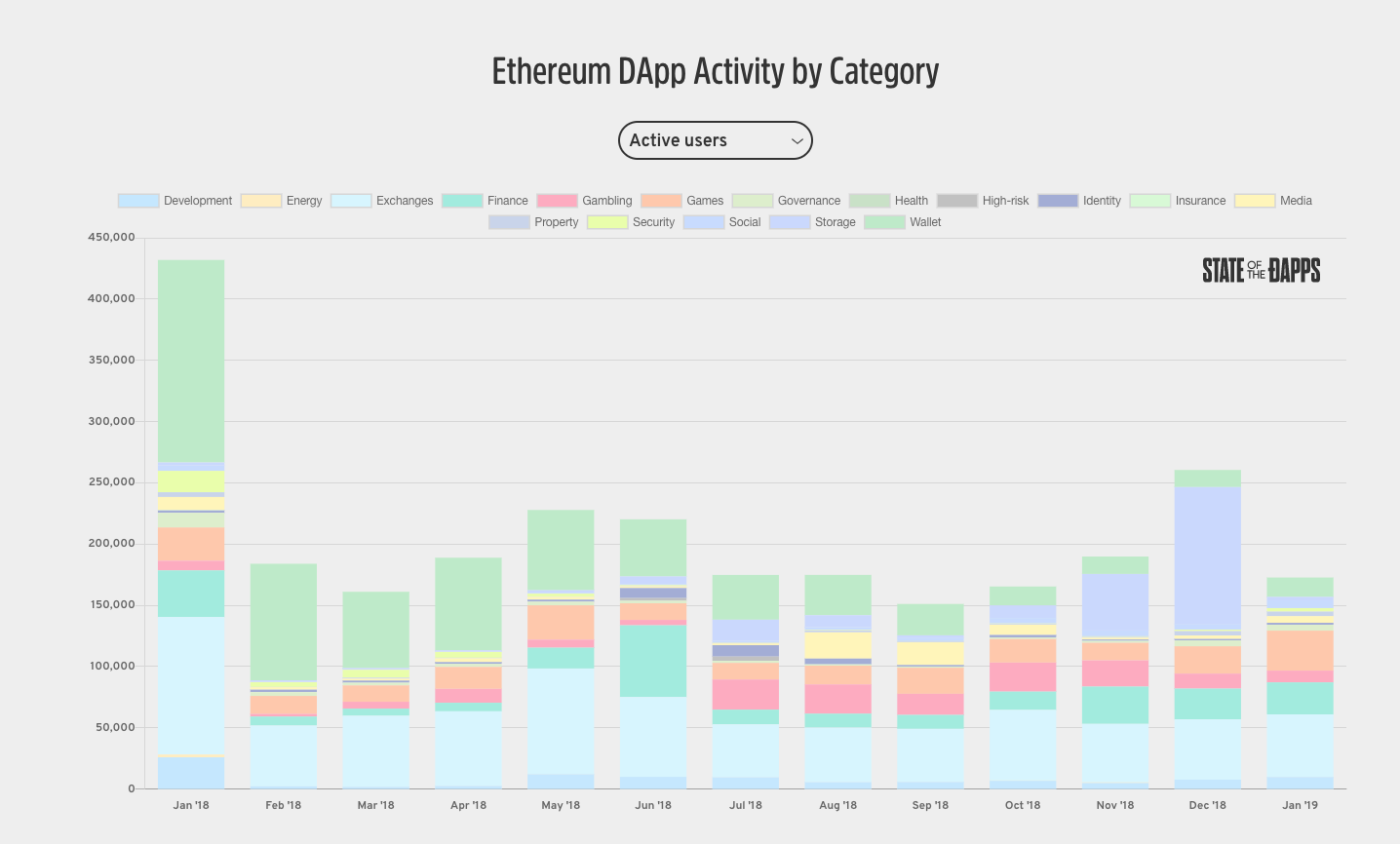
Fast-forward four years, and in many ways, we’re still waiting for this promise to be fulfilled. While applications from prediction markets like Augur to collectible games like CryptoKitties have launched on the network, most have failed to attract sustained usage and anything close to the billions of daily active users seen on consumer applications from companies like Facebook and Google. State of the Dapps currently shows that the current top Ethereum Dapp had a mere 3,000 users over the last 24 hours. Even if a Dapp were to attract mainstream adoption, it’s unclear if the network could support it — during the height of the CryptoKitties craze, Ethereum transaction fees rose to .02 ETH, or $20, at the time. As core projects have stalled, Dapps have failed to attract users, and the overall cryptocurrency market has declined, Ethereum’s price has fallen from around 51% of Bitcoin’s market cap in January 2018 to around 17% today.
To live up to its potential and scale decentralized applications to millions or even hundreds of millions of users, Ethereum has to solve key problems around scalability and performance. To do so, Ethereum developers have introduced an ambitious Ethereum 2.0 roadmap that includes proof of stake, sharding, and much more. Here’s what investors need to know about how — and on what timescale — these developments could impact the fundamentals of ETH.
Looking to trade ether as Ethereum undergoes these fundamental changes? SFOX lets you capture arbitrage opportunities by trading ETH across all major crypto exchanges from a single account using our best-in-class smart-routing order types.
The Ethereum 2.0 Roadmap
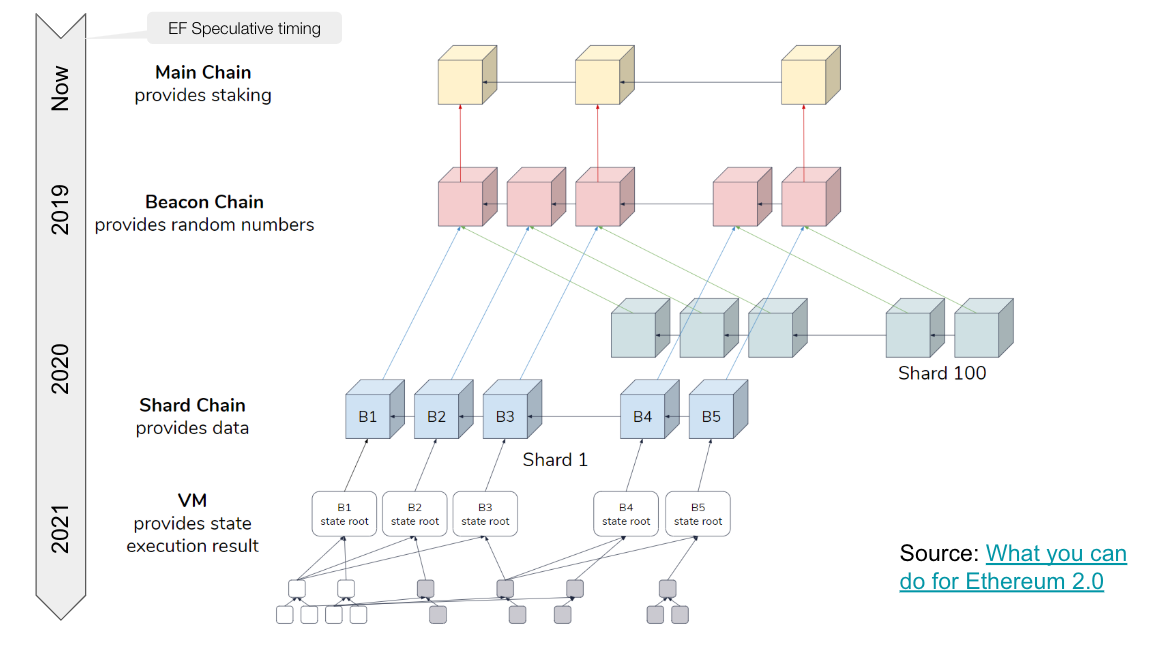
Many of Ethereum’s problems have to do with intrinsic shortcomings around speed and scalability. Solving these problems, while maintaining decentralization of the protocol, is the core priority of Ethereum 2.0.
When people say that Ethereum is a “decentralized smart-contract platform,” they mean that the code of a smart contract is stored on every full node on the network and code has to execute across all full nodes. Ethereum’s proof-of-work consensus model means that this can take anywhere from three to eighteen minutes, depending on network congestion. As a result, deploying code on Ethereum is orders of magnitude more expensive than using a centralized service like AWS — and much, much slower.
Ethereum 2.0 is meant to help Ethereum scale, and it has two major goals:
- Introduce a proof-of-stake consensus mechanism, which will eliminate the need for expensive proof-of-work mining.
- Introduce sharding, which will improve the speed and throughput of ETH transactions.
Rather than trying to build these upgrades directly onto the main net, Ethereum 2.0 will build out a new, separate platform from the main chain that will eventually replace it in the future.
The Ethereum wiki maps out seven distinct phases for Ethereum 2.0, which will likely take several years to implement. Most of these phases are still in the research stage, without clear technical specifications. Before developers can actually build on Ethereum 2.0, the first three phases will need to be completed:
- Phase 0 — Beacon Chain: The Beacon Chain is a proof-of-stake chain that will run parallel to Ethereum’s proof-of-work chain. Initially, the Beacon Chain will be engineered for simplicity and will support neither smart contracts nor accounts.
- Phase 1 — Basic Sharding: Sharding is intended to help transactions scale by dividing the network across multiple shards, allowing the network to process many transactions concurrently.
- Phase 2 — eWASM: The eWASM is essentially a rebuilt Ethereum Virtual Machine that supports proof-of-stake and sharding. It will introduce smart contracts, accounts, and more to Ethereum 2.0.
The staged rollout of Ethereum 2.0 is intended to test each upgrade to the protocol in a safe environment without compromising security.
As Ethereum researcher Ben Edgington writes:
Building on a new platform like this, the Beacon Chain, allows us to introduce huge innovation unlimited by the constraints of today’s Mainnet, and, crucially, without having to do open-heart surgery on the currently running network.
In the rest of the article, we’ll walk you through the first three phases of the roadmap, which introduce proof of stake and sharding to Ethereum.
The Beacon Chain: Bringing Proof-of-Stake to Ethereum
The Beacon Chain is intended to serve as the nervous system for Ethereum 2.0 and introduce a proof-of-stake chain that will initially run parallel to Ethereum’s proof-of-work chain. The Beacon Chain is expected to launch in 2019.
Currently, Ethereum runs on a proof-of-work blockchain where miners compete to solve a difficult cryptographic problem. The solution to this problem is easy to validate but difficult to find, which means that proof of consensus requires a substantial investment in hardware and electricity costs. With proof of stake, consensus is achieved instead through a set of nodes known as validators. Each of these validators “stakes” a certain amount of ETH to participate in the consensus process. Validators propose new blocks to add to the chain and validate new transactions through a voting process. Validators are rewarded for good behavior and penalized for bad behavior (e.g., voting on invalid transactions).
The main responsibility of the Beacon Chain is to maintain a set of validators for proof-of-stake consensus that propose and validate new blocks to add to the chain. Each validator will have to stake 32 ETH. The Beacon Chain also randomly selects committees of 120 validators to vote on which blocks to include in the chain. Phase 0 of the Beacon Chain will be extremely barebones, with support for neither smart contracts nor accounts, but it will set the stage for further developments down the line, such as sharding and an updated Ethereum Virtual Machine.
Proof of stake isn’t a new concept: it was discussed in the early days of Bitcoin on the BitcoinTalk forum back in 2011. One of the common criticisms of proof of stake is that it can lead to oligarchical control of the network by a small group of wealthy validators. The Ethereum 2.0 roadmap seeks to address this by experimenting with economic incentives and game theory, but it’s too early to know how this will play out.
Sharding: Ethereum 2.0 Scalability
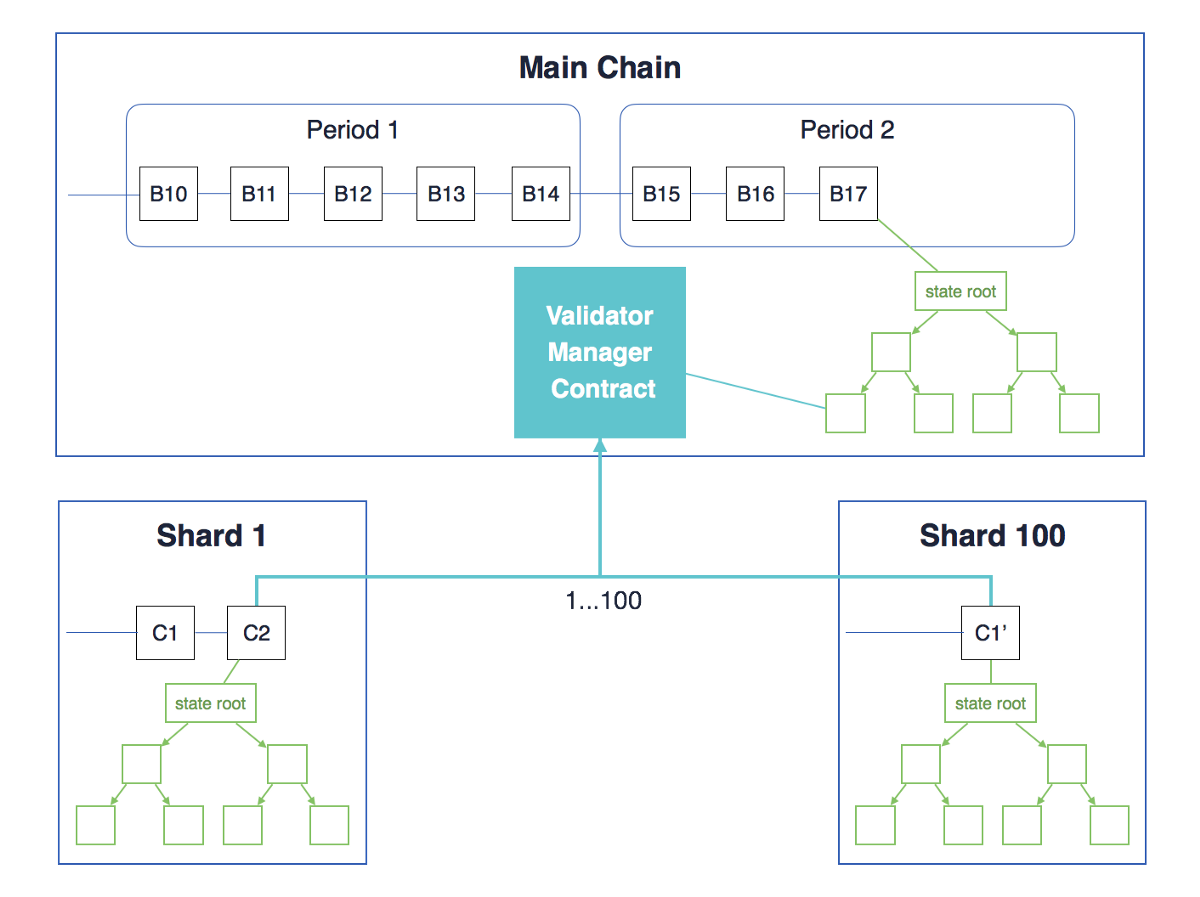
Currently on the Ethereum network, each full node validates every transaction. If you upload a smart contract to Ethereum, that means that it has to execute across every node on the network, limiting transaction speeds and throughput, while increasing the size of nodes to over 2 TB in size.
Sharding proposes to solve this problem in Ethereum 2.0 and help Ethereum scale. ‘Sharding’ refers to partitioning a large database into smaller, faster pieces known as shards. Each shard will have its own chain of transactions. Ethereum accounts will be assigned to a shard and can transact with other accounts on that shard. Eventually, the idea of Ethereum 2.0 is to facilitate cross-shard communication — but that won’t come until Phase 2 or later. On Ethereum 2.0, sharding works as the shared data layer for the network. Initial sharding for Ethereum 2.0 isn’t expected to launch until at least 2020.
Vitalik Buterin explains sharding as follows:
Imagine that Ethereum has been split into thousands of islands. Each island can do its own thing. Each of the islands has its own unique features and everyone belonging on that island, i.e., the accounts, can interact with each other and they can freely indulge in all its features. If they want to contact with other islands, they will have to use some sort of protocol.
Sharding on Ethereum in Phase 1.0 will be introduced on top of the proof-of-stake Beacon Chain. Shards will be verified by a set of validators that are randomly assigned by the Beacon Chain. A shard’s validators only have to verify transactions on the shard that they’re assigned. Phase 1.0 will introduce 100 shards that work in parallel, and initially, in this phase, they won’t process accounts, assets, or smart contracts.
While sharding brings scalability benefits to the network by splitting up a load of network transactions across shards, it introduces a new set of security problems. With proof-of-work, an attacker needs to amass 51% of the hashrate to successfully launch an attack. If the network is split into 100 shards, for example, it takes less of the network hashrate (or deposit in PoS) to successfully attack a shard. Another criticism is that sharding can lead to higher centralization, with each of the different shards run by a relatively small group of validators.
While the Ethereum developers have proposed solutions to these concerns — primarily through ensuring that validators are randomly selected — they still need to be tested, which is why the initial implementation of sharding will be limited.
eWASM: The Ethereum Virtual Machine v2
The current Ethereum Virtual Machine processes transactions sequentially. Each node on the Ethereum network executes transactions and stores them on the blockchain. To permit proof of stake and parallel transaction processing through sharding, the Ethereum team plans to build a new virtual machine known as eWASM. The eWASM is still in the research phase and will take at least until 2020 to build out — quite possibly longer.
This is the key to bringing smart contract functionality to Ethereum 2.0 and making it perform similarly to Ethereum 1.0 — only faster and better.
According to the specification for eWASM:
To truly distinguish Ethereum as the World Computer we need to have a very performant VM. The current architecture of the VM is one of the greatest blockers to raw performance. WebAssembly aims to execute at near native speed by taking advantage of common hardware capabilities available on a wide range of platforms. This will open the door to a wide array of uses that require performance/throughput.
The introduction of eWASM should allow Ethereum 2.0 to support smart contracts, accounts, states, and more. However, the eWASM still remains in the research phase of development, and it will likely change considerably before being pushed to production.
Ethereum 2.0 is a Marathon, Not a Race
“Ethereum 1.0 is a couple of people’s scrappy attempt to build the world computer; Ethereum 2.0 will actually be the world computer.” — Vitalik Buterin
For investors in Ethereum, the most important thing to understand about the Ethereum 2.0 roadmap is that it proposes a radical overhaul of the protocol — and that will take a lot of time and back-and-forth to realize.
According to a report from Kyokan, which conducted interviews with multiple teams involved with Ethereum 2.0, delivery of the first three phases will take at least a year and a half. Counter to popular media narratives, investors should be aware that each of these phases needs to be delivered before developers can actually build on top of Ethereum 2.0. Further, many of the later phases on the roadmap remain in the research phase of development, which means that new research can invalidate parts of the roadmap or introduce significant delays.
If Ethereum 2.0 can solve hard problems around proof of stake and sharding, then it may be well-poised to maintain its lead as the biggest smart-contract-computing platform in cryptocurrency. But that certainly won’t happen overnight.
About SFOX: Since 2014, SFOX has been providing institutions, pro traders, and anyone serious about trading crypto with the most advanced investment platform available anywhere. Capture the best prices on BTC, ETH, LTC, BCH, BSV, ETC, and RVN anywhere in the crypto market from a single trading account with smart-routing order types you won’t find anywhere else. Sign up now and see why SFOX has facilitated over $11 billion in trading volume to date.
The above references an opinion and is for informational purposes only. It is not intended as and does not constitute investment advice, and is not an offer to buy or sell or a solicitation of an offer to buy or sell any cryptocurrency, security, product, service or investment. Seek a duly licensed professional for investment advice. The information provided here or in any communication containing a link to this site is not intended for distribution to, or use by, any person or entity in any jurisdiction or country where such distribution or use would be contrary to law or regulation or which would subject SFOX, Inc. or its affiliates to any registration requirement within such jurisdiction or country. Neither the information, nor any opinion contained in this site constitutes a solicitation or offer by SFOX, Inc. or its affiliates to buy or sell any cryptocurrencies, securities, futures, options or other financial instruments or provide any investment advice or service.
